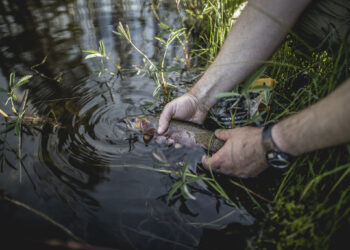By Jack Buban GUEST COLUMNIST
The Gallatin River isn’t just a scenic backdrop to our lives; it’s a vibrant ecosystem that supports a world-class trout fishery and everything that depends on it. And if there is one thing that can help us better understand the health of this sensitive and living environment, it’s the bugs that call it home.
While we can use what is visible to us in and along the river as indicators of how healthy the Gallatin is, what we can’t see—the life beneath the surface—is arguably more, or equally, important. To get to the bottom of bug health in the river, the Gallatin River Task Force embarked on a partnership with The Salmonfly Project, a Missoula-based aquatic insect conservation group. The big takeaway? That this is a great place to start in our quest to find out the baseline, and trends, in bug health. More data collection will be necessary to get an adequate handle on what people want to know: are the bugs in the river declining, and if so, what does that say about the Gallatin’s health overall?

Why bugs matter
Aquatic insects aren’t just fish food; they are the foundation of the river’s food web. Without a healthy and diverse insect population, the fish and other animals that call the Gallatin home simply cannot thrive. Certain species, like salmonflies, western green drakes, and golden stoneflies, are also indicator species. Their presence in high numbers signals that the river’s water quality is excellent, as these bugs don’t do well in oxygen deprived environments, and factors like algae blooms decrease available oxygen in the water.
The problem is, we don’t have much historical data on the Gallatin’s aquatic insects. While some exists, and more is being collected by the Montana Department of Environmental Quality as part of the ongoing algae study, it’s not detailed enough to track changes in individual species or communities of insects over time.
Given the river’s high ecological and human value, it’s essential to fill in this knowledge gap to learn more about the foundation of the Gallatin’s food chain. When anglers express concerns about potential shifts in major insect hatches, it’s a sign that something might be changing in the river’s health. And ultimately, no bugs equals no fish.
What we found
In this recent study, we collected data from nine sites along the Gallatin—both upstream and downstream of Big Sky—from the boundary of Yellowstone National Park to Spanish Creek. Our findings revealed that the overall abundance of aquatic insects is comparable to other well-known trout streams in the Greater Yellowstone region. That’s the good news.
The more nuanced finding, however, is that while the Gallatin has a very high number of insects, there’s a distinct skew towards pollution-tolerant species such as midges and blackflies, both up- and downstream of Big Sky. This means the Gallatin has a healthy number of sensitive bugs like stoneflies, mayflies, and caddisflies but the numbers of less-sensitive species are higher than expected for a healthy mountain river.

Without more historical data, we can’t say for certain if the populations of sensitive species are declining or if the tolerant species are simply increasing. What we do know is that the river still supports a much higher density of salmonflies and other stoneflies than rivers like the Madison and Big Hole. This is a testament to the river’s overall health, and suggests that recent algae blooms have not caused a severe decrease in population size for these insect groups.
The data we’ve collected has given us a valuable snapshot of the Gallatin’s current state, and continued data collection will be critical to understanding any shifts in these populations. The Gallatin River is a gem, with invaluable socioeconomic and environmental values, and by working together, we can ensure its health for generations to come.
How to get involved
The health of the Gallatin River is a community effort. If you’re interested in learning more, we have two great opportunities for you to join us. The Gallatin River Task Force and The Salmonfly Project will be hosting a presentation and Q&A session at the new Big Sky Center for the Arts on Monday, Aug. 25. Doors open at 5 p.m. and the presentation begins at 5:15 p.m.
We will also be out on the Gallatin River collecting data for the 2025 season from Aug. 25-28 and are looking for volunteers to help. To learn more, reach out to me at jack@gallatinrivertaskforce.org.
Jack Buban is the Community Engagement Manager at the Gallatin River Task Force.














